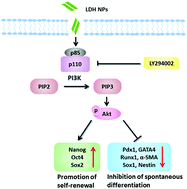Layered double hydroxide nanoparticles promote self-renewal of mouse embryonic stem cells through the PI3K signaling pathway†
Abstract
Embryonic stem cells (ESCs) hold great potential for regenerative medicine due to their two unique characteristics: self-renewal and pluripotency. Several groups of nanoparticles have shown promising applications in directing the stem cell fate. Herein, we investigated the cellular effects of layered double hydroxide nanoparticles (LDH NPs) on mouse ESCs (mESCs) and the associated molecular mechanisms. Mg–Al-LDH NPs with an average diameter of ∼100 nm were prepared by hydrothermal methods. To determine the influences of LDH NPs on mESCs, cellular cytotoxicity, self-renewal, differentiation potential, and the possible signaling pathways were explored. Evaluation of cell viability, lactate dehydrogenase release, ROS generation and apoptosis demonstrated the low cytotoxicity of LDH NPs. The alkaline phosphatase activity and the expression of pluripotency genes in mESCs were examined, which indicated that exposure to LDH NPs could support self-renewal and inhibit spontaneous differentiation of mESCs under feeder-free culture conditions. The self-renewal promotion was further proved to be independent of the leukemia inhibitory factor (LIF). Furthermore, cells treated with LDH NPs maintained the potential to differentiate into all three germ layers both in vitro and in vivo through formation of embryoid bodies and teratomas. In addition, we observed that LDH NPs initiated the activation of the PI3K/Akt pathway, while treatment with the PI3K inhibitor LY294002 could block the effects of LDH NPs on mESCs. The results confirmed that the promotion of self-renewal by LDH NPs was associated with activation of the PI3K/Akt signaling pathway. Altogether, our studies identified a new role of LDH NPs in maintaining self-renewal of mouse ES cells which could potentially be applied in stem cell research.


 Please wait while we load your content...
Please wait while we load your content...